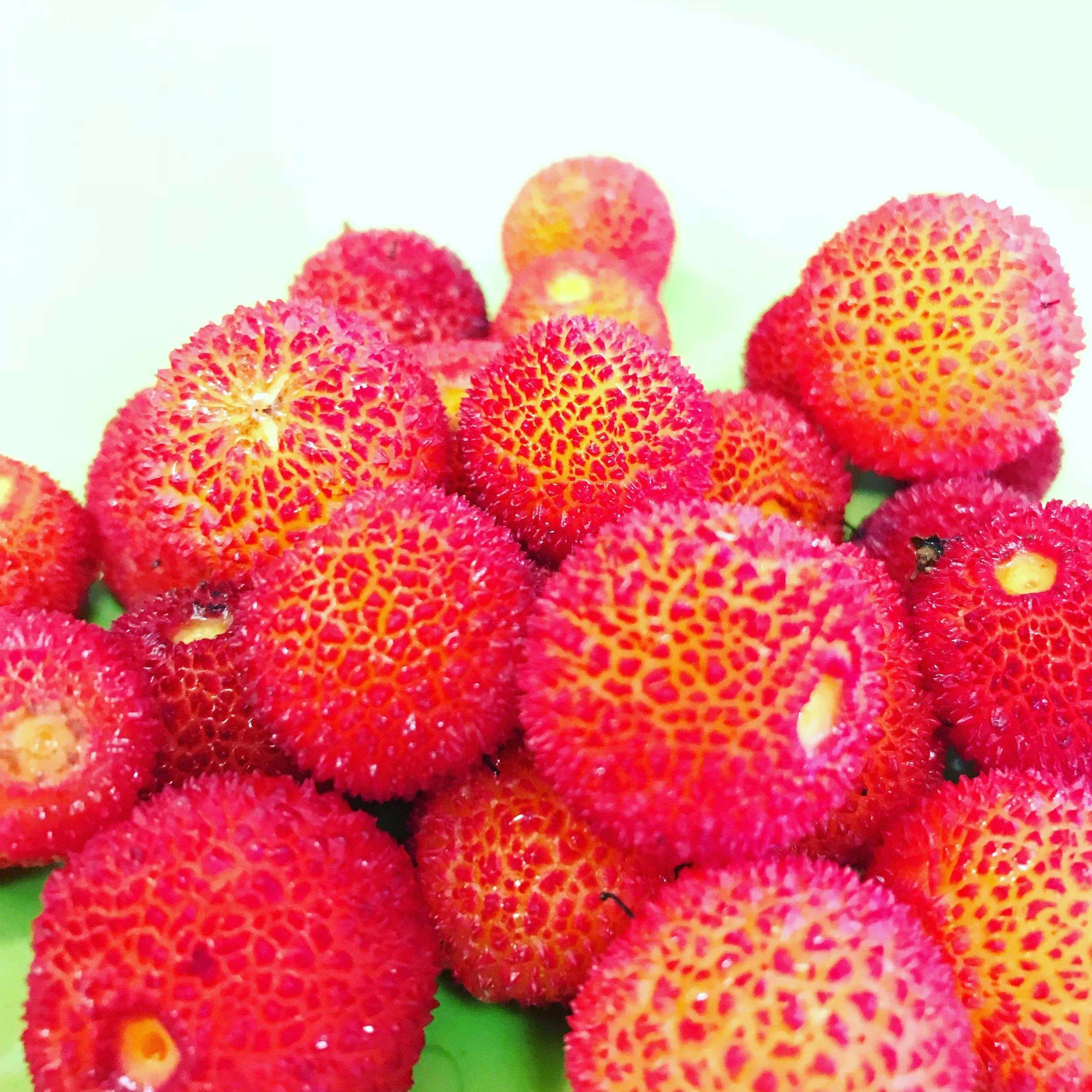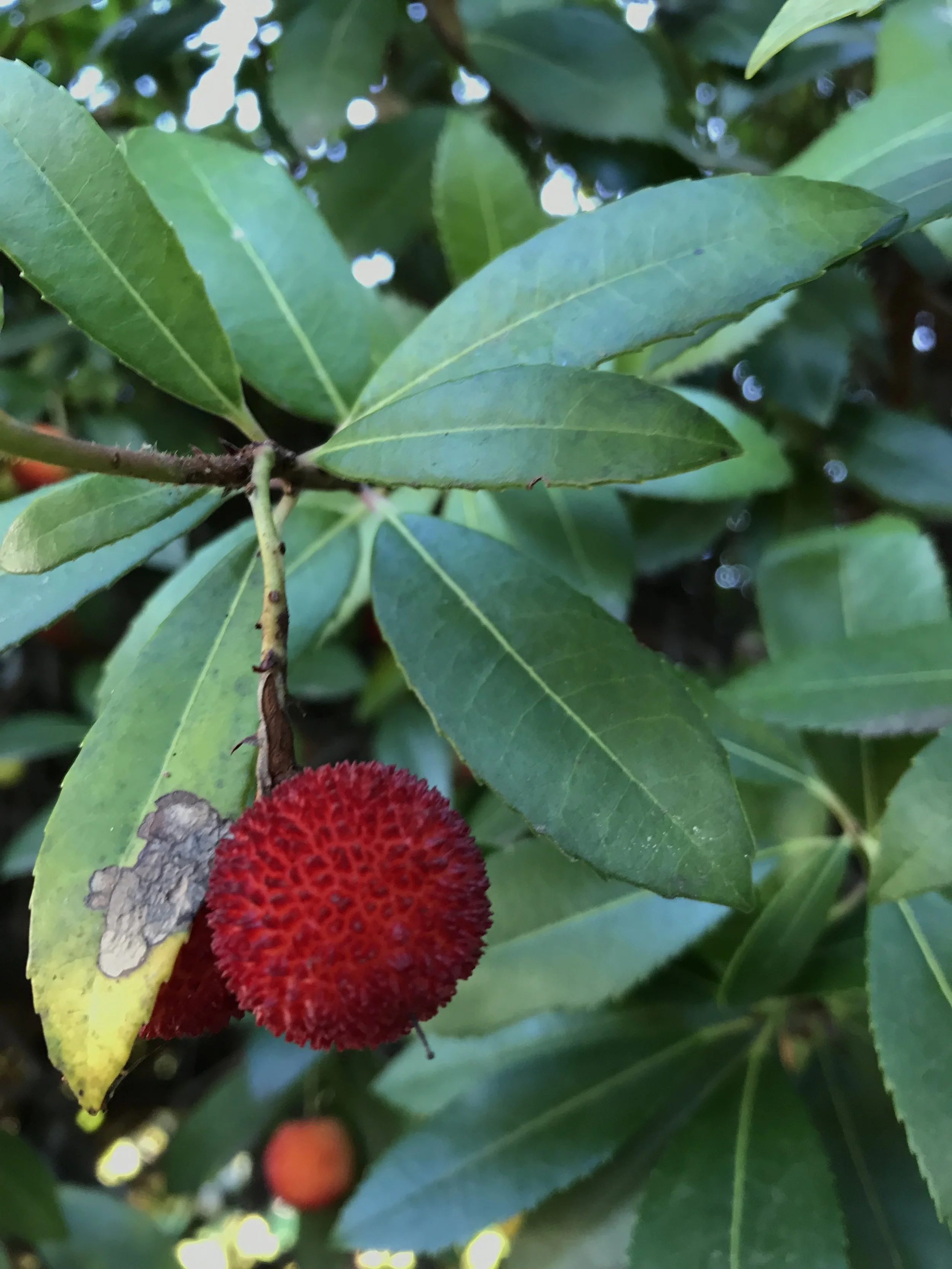Strawberry Tree: Unedo Try This Fruit Once
Arbutus unedo
Strawberry Tree Fruits. Fruits and photograph taken and eaten by the author.
You rarely hear a human stand up and testify to the flavor of strawberry tree fruit.
“Mmmmmm MMMMMMMM! This berry tastes like mushed peaches and sand! Try one, Gwendolyn!”
Very Few
I’ve read various iterations of the above “sandy peaches” description many times before, however, being faced with the opportunity to try the berry for the first time recently, I had a more pleasant experience.
If you were to take a mealy/out-of-season peach, sweeten it with a tiny bit of mango, and combine this mixture with raw cornmeal until you can form numerous 1-inch spheres. Boom! This would be as faithful an analog for the fresh fruit you are bound to find.
Commonly seen as an ornamental guest in the parks, roadsides, and apartment complexes of the Pacific Northwest, the Strawberry Tree, and its berries, have been used to create jams, jellies, and boozy hootches of various stripes the world over.
The soft red fruits plucked off of a bush on a brisk autumn day are soft like gummy candy. There is a strange allure about the berries that begs: “smoosh us together, weirdo!”
I don’t mind if I do, Strawberry Tree!
*pbbbbttttt
Welcome to the nitty-gritty, drunken-stumbly, and smushy-gushy world of Arbutus unedo.
Image retrieved under Creative Commons licensure [5]
Description
Arbutus unedo is an attractively ornamental broad-leaved evergreen with glossy, oval/obovate, serrated, alternate leaves which are 5-10 cm (2-4 inches) in length. The urn shaped, opalescent white-to-pink flowers present in panicles and dangle like medallions. The soft and ripe fruits are globose (spherical) and covered in a rough/bright-red surface texturing.
El Oso y el Madroño, or, The Bear and the Strawberry Tree, is landmark statue and meeting place in the city of Madrid, Spain. Image retrieved under Creative Commons licensure from HERE.
Culinary Uses
In Italy, the berries were used to make wine and brandy [7]. The Portuguese make a fruit brandy from the strawberry tree called Aguardente de Medroñho and the Albanians call their version of Strawberry tree booze, Raki Kocimare [8]. The fruits can be eaten fresh or used to create highly esteemed jams. The fruit can also be used to make muffins, pies, and candy [8].
Strawberry Tree Fruit. Photo taken by Kevin Healey.
Ethnobotany
The berries, known as lendj, are moderately esteemed among Algerian schoolchildren [4]. Libyan locals were known to use a decoction of the leaves and fresh fruits to treat disease of the kidneys [6].
Folk Remedies
The fruits are generally used for antiseptic, laxative, and diuretic (like seemingly every plant ever) properties [3]. The leaves are used for astringent, antiseptic, and diuretic properties as well as in folk treatments for diabetes and hypertension [3].
Music
Historical Note
The Strawberry Tree has appeared as a fixture on the official coat of arms for Madrid, Spain, since the 13th century.
El Oso y el Madroño, or, the Bear and the Strawberry Tree is the official coat of arms of Madrid, Spain.
Literature
My Love's an Arbutus
By Alfred Perceval Graves
My love's an arbutus
By the borders of Lene,
So slender and shapely
In her girdle of green.
And I measure the pleasure
Of her eye's sapphire sheen
By the blue skies that sparkle
Through the soft branching screen.
But though ruddy the berry
And snowy the flower
That brighten together
The arbutus bower,
Perfuming and blooming
Through sunshine and shower,
Give me her bright lips
And her laugh's pearly dower.
Alas! fruit and blossom
Shall lie dead on the lea,
And Time's jealous fingers
Dim your young charms, Machree.
But unranging, unchanging,
You'll still cling to me,
Like the evergreen leaf
To the arbutus tree.
Nutrition
The fruits are abound with antioxidants and dietary fiber [4].
Recipes
I am planning on giving this jam recipe a whorl: Strawberry Tree Jam.
More Videos…
Pull Up Your Plants! (PUYP) is now receiving visits from all over the world. Please take the time to leave a comment or subscribe below. I’d like to hear about your experiences with …
For source citations, please email Kevin Healey at
pullupyourplants. @ gmail.com
With Love,
Kevin.




![Image retrieved under Creative Commons licensure [5]](https://images.squarespace-cdn.com/content/v1/59bae60f1f318d07a99856a4/1538891813820-5OTGKK3WV46FKQK1LLUO/Screen+Shot+2018-10-06+at+10.56.11+PM.png)




